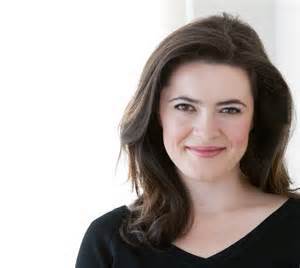K.L. Going's Blog
April 18, 2018
Talking with Clara Gillow Clark about our Highlights workshop, Novel Beginnings
For the second time, Clara Gillow Clark and I are co-faculty for an upcoming workshop at the Highlights Foundation: Novel Beginnings: Building Strong Foundations for Your Novel and Your Career. Here we share some thoughts about writing novels, and about the workshop.
Research. How much research do you do before writing?
Kelly: I do a lot of research, even when writing fiction. In fact, I sometimes think I do too much. It’s very easy to put off starting the actual writing process by reading just one more book in the name of research.
The truth is, I find research to be a lot of fun. I read about various topics that relate to my story idea and sometimes I’ll read books that relate to how I might structure the narrative. For example, if I’m debating about using flashbacks, I might read a few examples of books that use them well. Or if I’m considering a narrative style that jumps around in time, I might see if I can find other examples of this style. That said, I never read anything that’s too close in plot, setting, or character because I don’t want to unconsciously affect my decision making on that level.

Clara Gillow Clark
Clara: Before I begin to write I do months of research and then continue to research throughout the writing of a book. Here’s a little writing tip: If you can’t see it; you can’t write it. That’s why research is not just important, it’s necessary for any time period you’re writing in if you want to capture a past or present time and bring it to life.
Research gives the writer building blocks to saturate their narrative with vivid and specific details. I want the reader to taste, touch, taste, smell, hear, and see the fictional world. When we write about the past, research also helps us shed our 21st-century sensibilities to embrace the mannerisms, belief systems, a different way of seeing the world, and the emotional pulse of a past time that may be alien to us.
How much of the story is developed through imagination–daydreaming about the characters, setting, and plot?
Kelly: All of it! Daydreaming is how I come up with my ideas for every stage of story development. I think about all the different paths that the plot could take and imagine the twists and turns as far as my mind allows. I imagine the same story using one element and then change that element to its polar opposite and imagine the story again. What changes? What do I like better? Were there any surprises?
As an example, I might think I want to write about a family that consists of a mother, father, and my main character. But there are so many permutations of family and every different combination changes who my main character would be and how they would act. I might change certain elements in my mind, imagining how the plot would unfold if the parents are divorced, happily married, together but constantly fighting, etc. Each path leads to a main character with different traits: angry, naïve, confused, betrayed, seeking escape…These character traits in turn define the plot.
It’s easy to make choices that become set in our mind right from the start, but sometimes, changing one single character or action can end up defining your entire book.
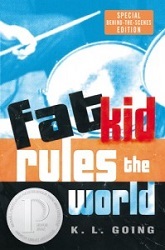 If you look back at my original hand-written pages of Fat Kid Rules the World, you’ll see a character who didn’t make it into the story: Troy’s mom. At some point, I reimagined the story without her and found that there was a deep well of emotion and conflict with a single dad struggling to raise two boys on his own.
If you look back at my original hand-written pages of Fat Kid Rules the World, you’ll see a character who didn’t make it into the story: Troy’s mom. At some point, I reimagined the story without her and found that there was a deep well of emotion and conflict with a single dad struggling to raise two boys on his own.
Clara: Research is the vehicle by which a writer builds their fictional world and that’s also where imagination comes in. As I research, I start building sets in my mind, sort of like movie sets–rooms with furniture, neighborhoods, kinds of transportation and types of stores, as well as the larger setting of the natural world, fashion, food, manners, superstitions, important historical events, and so much more. This process is delightful child’s play where I pick up bits of research and try them on, model them so to speak, to see if they work. Some things get discarded, other things are kept and often embellished to enhance the setting or a character’s personality. But the daydream can’t blossom into story until I have a reason to write the book. Then I need a major character I care about who is conflicted and to that I add in other primary relationship characters to generate conflict and friction, offer support or create confusion for the main character and to ultimately touch an emotional chord in the reader.
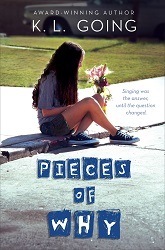 How much of the story’s content springs from your emotional connection to the story?
How much of the story’s content springs from your emotional connection to the story?
Kelly: All of it! Again, this is at the very heart of story development. There’s something mysterious about the way the passion you feel in your mind and heart gets transferred onto the page. It doesn’t seem like a reader should be able to tell how I feel as I write, but over and over again, I’ve seen the results. When I am deeply emotional about a scene, it works, but when I’m writing something that I feel less connected to, most of the time it ends up getting cut in the end.
Clara: Everything. It’s commonly believed that you can’t write something that’s other than yourself. But haven’t we all been a target or experienced life being acted out on us? And if we closely observe and put ourselves in another’s shoes to discover their wounds and fears, and if we can then see with clarity and compassion and forgiveness, why can’t we then write from another’s point-of-view whose actions are things we would never do or say not even in our thoughts? But, I would say, that YES, everything springs from our life experience, but not necessarily our own thoughts and actions.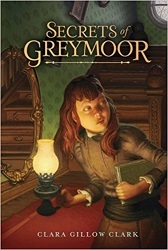
How do you know if a story idea is strong enough to support an entire novel?
Kelly: To me, this goes back to that all important step: imagination. When I take time to imagine, I can see whether a trail quickly runs out, or whether I’m bursting with possibilities. I’ve had numerous ideas that seem funny or interesting at first, but when I start to play them out in story form, there’s not enough to turn that idea into an entire book.
How do we pull it all together?
Clara: I’ve pretty much stated that above, but to recap, getting ready to write is having your three prongs of story working together in your mind–i.e. research, imagination, and emotion. When the characters start saying things and doing things and feeling emotions then I know it’s time to write.
How do you know when it’s time to write?
Kelly: For me, there’s a feeling of urgency that begins to build. Also, because I spend so much time imagining different possibilities, there’s also a point where I feel like my imagination is tapped out. I think of this part of the process like playing chess. When you’re playing, you try to consider each move and its consequences. Some players are capable of thinking many moves ahead. Others can think one or two moves ahead. Either way, there’s a point where you’ve done all of the thinking you can, and it’s time to choose the best path and make your move.
How many drafts do you do before you submit your work?
Kelly: This varies from project to project, but I guarantee it’s more than most people expect! It’s also less quantifiable because I often read through partial drafts and edit as I’m creating.
In an ideal world, I’d start each new chapter by rereading the previous one, so I’d clean up the text as I write. Then after a complete draft is finished, I’d put it away for at least two weeks so I could come back to it with fresh eyes. I’d revise a minimum of three times before passing the novel on to a team of carefully selected readers who would give me feedback. Then I’d take their feedback, incorporate it, and revise again as many times as needed.
Of course, this is a perfect scenario and we all know that writing is messy! Our best laid plans seldom work out the way we want them to! My best advice? Revise as many times as you need to, and don’t feel self-conscious about how many drafts you take to get it right. What matters is the end result, not how long it takes you to get there.
 Clara: Each project is different. For Hill Hawk Hattie the beginning came fully formed into my head when I was out walking–walking is when I do a lot of daydreaming and when characters talk to me–and the opening of that book never changed much from that moment Hattie entered into my conscious and started telling me her story. But I had spent years gathering research about the heyday of the rafting era on the Delaware River so the stage was set. But it’s also not unusual for me to do countless drafts of a scene or chapter and then toss them out or to tinker endlessly with words and phrases, always asking myself, “How can I say this better?” After I’ve completed a draft, I count on a feedback from trusted friends, and more often than not that will require several more drafts before the manuscript is even close to submission.
Clara: Each project is different. For Hill Hawk Hattie the beginning came fully formed into my head when I was out walking–walking is when I do a lot of daydreaming and when characters talk to me–and the opening of that book never changed much from that moment Hattie entered into my conscious and started telling me her story. But I had spent years gathering research about the heyday of the rafting era on the Delaware River so the stage was set. But it’s also not unusual for me to do countless drafts of a scene or chapter and then toss them out or to tinker endlessly with words and phrases, always asking myself, “How can I say this better?” After I’ve completed a draft, I count on a feedback from trusted friends, and more often than not that will require several more drafts before the manuscript is even close to submission.
Novel Beginnings: Building Strong Foundations for Your Novel and Your Career
June 21-24, 2018
Get feedback on your novel AND guidance about your writing career!
Find out more.
The post Talking with Clara Gillow Clark about our Highlights workshop, Novel Beginnings appeared first on KL Going.
October 19, 2017
Inspiration: The Shape of the World
Note: This was originally posted on Clara Gillow Clark’s blog Writing From the Inside Out.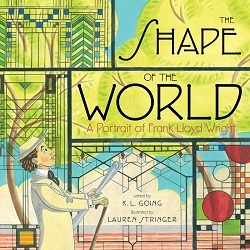
“Talent is good, practice is better, passion is best.” Frank Lloyd Wright
I never paid much attention to architecture growing up. Buildings – even the most beautiful ones – were something I took for granted. It wasn’t until later in life that I started to think about architecture as something to be admired and appreciated, and that appreciation began with my father.
The Shape of the World is dedicated to my dad because it was his love of Frank Lloyd Wright’s work that made me take a second look at the world around me. At first, I looked at Wright’s buildings and appreciated the way they mimicked the natural world. This led me to thinking about how buildings can be works of art within our daily existence or mundane functional objects that add little to our lives. What do our buildings say about us? When the minutia of society has crumbled away, what will future archeologists find revealed in our architecture?
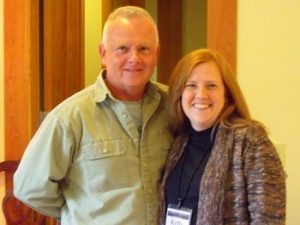
K.L. and her dad.
Winston Churchill once said, “We shape our buildings; thereafter they shape us.” Just like books, architecture is a gift we give to our children.
K.L.’s dad and son.
“Every great architect is – necessarily – a great poet. He must be a great original interpreter of his time, his day, his age.” These are the words of Frank Lloyd Wright, and I believe they are true.
Appreciating the world we’ve built, leads inevitably to appreciating the world that nature has built. When we stop to admire beauty in one form, we will appreciate it in all forms. These are wonderful lessons for adults and children alike.
My hope for The Shape of the World, is that this book will inspire children to take a look at the world around them much earlier than I did. I hope they’ll be challenged by Wright’s example to make the world that they create as beautiful as the natural world around them.
As Frank Lloyd Wright once said, “If you foolishly ignore beauty, you will soon find yourself without. But if you invest in beauty, it will remain with you all the days of your life.”
We create the shape of the world. All of us, together.
It is our sacred task.
May we rise to the challenge, and may we equip our children to do the same.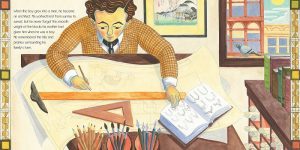
About the Book:
A little boy who loves to find shapes in nature grows up to be one of America’s greatest architects in this inspiring biography of Frank Lloyd Wright. When Frank Lloyd Wright was a baby, his mother dreamed that he would become a great architect. She gave him blocks to play with and he learned that shapes are made up of many other shapes. As he grew up, he loved finding shapes in nature. Wright went on to study architecture and create buildings that were one with the natural world around them. He became known as one of the greatest American architects of all time.
Reviews:
A spot-on introduction to Wright and an evocative recognition of the way a child is father to the man.”—Booklist, starred review
Simple prose set in a light type that reflects Wright’s art serves as a jumping-off point for each of the expansive illustrations, giving young readers ample opportunity to discover hidden gems in the pages, such as the red squares that are scattered throughout Wright’s work. A lovely introduction to the impact that a creative mind can have on the world.”—Kirkus
The post Inspiration: The Shape of the World appeared first on KL Going.
October 17, 2017
Inspiration: Bumpety, Dunkety, Thumpety-Thump
Note: This was originally posted on Clara Gillow Clark’s blog Writing From the Inside Out.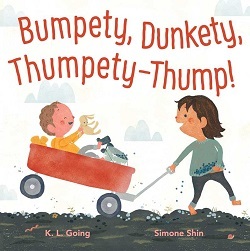
Sometimes two things that seem to share nothing in common are actually connected by a gossamer thread, an unseen strand that exists only in the artists’ mind. Inspiration. It can come from anywhere at any time, merging unique things together into a brand new artistic experience.
The initial seed of inspiration for Bumpety, Dunkety, Thumpety-Thump came from reading Eric Carle’s The Very Busy Spider to my young son. Ashton was only a toddler at the time, but he loved to run his fingers over the raised lines of the spider’s web.
As a picture book author who has also worked in publishing, I know that “extra” features, like the raised line, cost publishers more money, which is why they are rare instead of common. Yet I wished there could be more books like this on the market because children love to explore textures.
I wondered if there might be a way to recreate a tactile sensory experience using words.
That’s when I thought about yet another wonderful read-aloud picture book. Chicka Chicka Boom Boom by Bill Martin Jr. has been a favorite since its publication by Simon & Schuster in 1989. Could rhythm help to replicate the senses?
I decided to create a text that used words and rhythm to bring alive the sounds and textures of the world around us, and hopefully in the process, invite children into an imaginative state where they can experience the bumping, thumping, playful world all around us.
The result is Bumpety, Dunkety, Thumpety-Thump. I hope you and your little ones will enjoy the experience of reading this book together!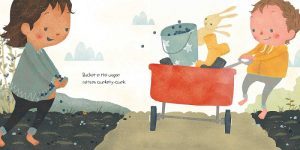
About the book:
Wagon on gravel goes bumpety-bump.
Pebbles in the pond fall plunkey-plunk.
Toes in the grass dance thumpety-thump.
Bumpety-plunkety-thumpety-thump!
Join two sweet siblings as they explore their backyard, get deliciously creative in the kitchen, and then spend a cozy evening preparing for bed. Along the way they’ll get muddy and messy and hungry and sleepy—just as all little ones do.
Reviews:
This winning read-aloud should encourage multiple recitations.”—Kirkus
An obvious choice for storytimes or units on rhymes, this will also be great for introducing beginning writers to the wonders of words—especially those that don’t appear on standard vocabulary lists.”—Booklist
This onomatopoeic book is a lively read-aloud that will be requested often for storytime or bedtime.”—School Library Journal
The post Inspiration: Bumpety, Dunkety, Thumpety-Thump appeared first on KL Going.
January 23, 2017
Novel Beginnings: An Interview with author Clara Gillow Clark
March 16-19, 2017, I will be co-hosting a Highlights workshop with the lovely and talented Clara Gillow Clark. We only have a few spots left open, so if you’re interested in registering, you can find out more through the Highlights Foundation.
Hope you enjoy this interview! We’d love to have you join us!

Q. What makes the start of writing a novel so challenging?
CGC: Before I begin to write a novel I go through a spell of what I call “dream time” when a character has caught my attention who has a story that wants to be told. Dream time is sweet, the sweetest part of the writing process for me. I always walk my stories, and that’s when scenes come to life and characters tell me things. What a shivery sort of thrill it is when that happens. The opening pages start to take on shape as I jot down notes. But, still I wait. And I wait some more, waiting for the character to share her secrets with me. And still I wait. Images come. Maybe they’ll turn into a symbol or a metaphor, but it isn’t until I can see where my character will be at the end of the book, that I sit down to write.
Usually, some of the first chapter comes out smoothly and fully formed, but there are always hard places where the writing is a struggle. Likely, it’s that unwieldy back story that begs to be included in the very beginning, because I really MUST put it there. Or I decide a prologue would be nice, which always seems a delightful way to begin and such a great way to slip in all the information readers MUST know. Kill the prologue. Give it up. Then I remind myself of Flannery O’Conner’s words to writers: Don’t worry about what to say; just make pictures and conversation. And that’s what I try to do.
Q. What do you know now that you wish you’d known at the start of your career?
CGC: Everything changes. Everything. We write and over time we become confident and feel comfortable with our style and our writing voice; and at the beginning of our careers when we’re first published, we think it will always be that way. We do all the right things–study craft, practice craft, and read other authors’ works. One day we realize the industry is changing, and it’s not just a trend. The reality is that both publishing and language is influx and will continue to be so in the future. But know this: It has always been true that we need to be original and unique in our vision for a story that has a thousand faces already. That’s where I am now, reinventing myself and my writing, going deeper, but still always writing from the heart. Embrace change and don’t be afraid. Keep reading and your vision will adjust.
Q. What is a common mistake you see when critiquing new writers?
CGC: Most new writers who are serious about the craft of writing have a pretty good grasp of story, because they’re readers. But often when we read, we zoom in on the action and read on to find out what’s going to happen next. We see the twists and turns, the pitfalls and setbacks, but seem to miss what’s really driving the cart over that cliff, which is emotion. Often aspiring writers skip right over the interior development of their protagonist and often tell instead of show their character’s emotion. Other things that are often problematic for new writers are deep point-of-view, verb tenses – especially if they’re writing in the present tense, and transitions.
Q. What are you most looking forward to about our upcoming Highlights Foundation Workshop, Novel Beginnings?
CGC: Meeting new writers, mentoring, but also experiencing that warm feeling of a kind of homecoming. That’s how I feel when I’m at the Foundation. I’m in a safe and nurturing environment with like-minded people who love to learn, love books, and want to be better writers. I’m looking forward to forging new friendships, but also seeing old friends who work there like Chef Amanda. What could be better than that?

Learn more about our upcoming workshop by clicking on the link: Novel Beginnings: Building Strong Foundations for Your Novel and Your Career 2017
The post Novel Beginnings: An Interview with author Clara Gillow Clark appeared first on KL Going.
October 8, 2015
One More School Shooting: What Will it Take?
After last week’s shooting at Umpqua Community College in Oregon, something small but significant happened.
For the first time, the question that popped into my mind immediately upon hearing the news was not “why”. For the first time, my mind didn’t scream at me to try and decipher the motives of the killer or why evil exists. No. This time, the very first question that popped into my mind was, “What will it take?”
What will it take for our society to change? How many more shootings will have to happen? Is there any scenario that would be horrible enough to force us into action right now?
Honestly, my feelings about that last question are bleak. If the mass murder of elementary school children at Sandy Hook wasn’t enough, then I can hardly bear to contemplate the kind of scenario that would be necessary to prompt us to take definitive action. We already have too many years of experience showing us exactly which direction the trend of gun related violence is moving in. We know that mass shootings WILL keep happening. Maybe to me. Maybe to you. Maybe even to our children. Why isn’t that enough?
What will it take?
I’ve said it before and I’ll say it again, although these shootings can and do happen in other countries, no other developed nation is dealing with them on the same scale as the United States. Australia experienced a mass shooting in 1996, enacted strict gun control laws, and hasn’t had a shooting since. (Slate) Even if they had one tomorrow, they’ve still bought themselves years of reduced fear and death. How many lives have they saved? Not only has there not been a mass shooting since that time, but they’ve also had a reduction in homicides and suicides as well. And, at least one Australian (and I’d venture to guess many others) look at our country with pity, lamenting the fact that Americans lack the will to change.
Pity? For us? WE lack personal and political will? This is not how we’re accustomed to being described. Americans have always prided ourselves on our “can-do” attitude. When we decided to put a man on the moon, by god, we did it. That’s our story and we’re stickin’ to it. The will to accomplish anything we set our minds to, is part of our self-identity. And Freedom from Fear is part of our national heritage, right? This is who we are, isn’t it?
Speaking for myself at least, I’m hugely impacted by fear of mass shootings. Yesterday the headline of my paper was about a man threatening a mass shooting at my local mall. The mall I went to twice last week. The mall I take my child to. As I write this, there are a ton of sirens sounding in the distance. I live in the country, so that’s rare. I also live within walking distance of my son’s school, and it’s all I can do not to get on the phone and demand to know that nothing is wrong. That the fire trucks and police vehicles I hear screaming past aren’t going to be on tonight’s news.
Yet, gun related violence continues even though it’s a solvable problem. Maybe we can’t eliminate gun related deaths completely, but we can certainly curb them. If you had cancer, you’d want them to start treatment, right? Eliminate as much as they possibly could? You wouldn’t wait for a 100% guaranteed cure before you took action. Well, we’re sick. Some of us are dying. And we have a blue-print for change that’s been tested by time and experience.
So what will it take for us to move forward?
Unfortunately, I believe part of the answer is that issues often have to get personal before we’ll enact change, especially if the change required is difficult or makes us uncomfortable. Our *personal* level of discomfort must outweigh the level of discomfort that change would demand of us. So, for many people, they’ll worry about gun control once gun violence impacts them. My fear is that change won’t happen until enough communities, families, and individuals have been *directly* affected for the scales to tip. In Malcolm Gladwell’s words, that would be the tipping point. But is that really how we want our future to play out? Must we wait for the number of us who are personally impacted to outweigh the number who are still privileged enough to remain complacent?
Maybe this sounds harsh. The truth is, although I’m railing against this kind of passivity, in many ways, I understand the wait-until-it-affects-me way of thinking. We live in a world where we’re bombarded with the troubles of … well … an entire world. Were we designed to handle that? These days, it’s possible to plug in and become aware of everything from the refugee crisis, to the latest weather disaster, to the cruel treatment of animals, to wars, to mistreatment of women and children, to wrongs within our local community… the list goes on and on. And every one of these tragedies demands our attention and our action. Not just our physical action but our psychic and spiritual resources as well. How much can we handle before we need to unplug? How much horror is it healthy to internalize? So, it’s completely understandable (at least in my mind) why people disengage. Why we pick and choose. Why we wait to act until something hits home. Why we often fail to respond until we’ve been made personally uncomfortable.
I get it. But if the answer to “What will it take?” is that a mass shooting will have to happen to your community or your family before it becomes your issue, then that’s sad for all of us. Because while we’re waiting for the scale to tip, more and more people will lose their lives. And many of them will be children. They will be beautiful, bright young lives, extinguished before they had a chance to pursue their dreams. While we’re waiting to reach a tipping point, we’re also learning to live in fear – the fear of our children experiencing terror and death during what ought to be a routine school day. The fear of going to the mall or the movies. Or church. And although I can only speak for myself in this regard, I can say without doubt that, God forbid, my own son were a victim of a mass shooting, I would *never* forgive myself if I’d waited too long to speak out. If my own complacency, or my sense of entitlement, lead me to be silent until it was too late, I couldn’t live with the guilt and no amount of subsequent activism would ease that burden. That alone is enough motivation for me, but if I needed any more conviction it would come from my personal spiritual beliefs that ultimately your child is my child. That although I may not personally know this latest set of victims, on a deeper level we are all connected.
So, I choose to speak out now.
Not tomorrow. Not when the scales have tipped.
Now.
We must change.
****************************************************************************************************
Join a group. Write your legislatures. Give money and time to causes that support gun control. Write blogs and op-eds, letters to the editor, magazine articles… Post pictures of the victims so we can’t forget them. Use your artistic skills to make iconic images. Use your musical skills to share a song. Vote according to your passion. If you have a platform, use it, even if you think no one is listening. Do everything you can. Don’t stop. Don’t shut up. Keep going until there’s no longer any need for your voice to be heard because change has happened.
The post One More School Shooting: What Will it Take? appeared first on KL Going.
August 27, 2015
Hope and Violence in Children’s Literature
As the release date for Pieces of Why approaches, I’m often asked about the inspiration for this book. I’ll be honest, there’s never just one source of inspiration for a novel. The creative process is always an amalgamation. A crashing together of disparate life events, images, sounds, places, subjects I’m fascinated with, futures I’m afraid to confront…
In the case of Pieces of Why, there were three primary sources of inspiration, all of which had something in common: gun related violence. It might seem strange to think that the driving forces behind a book for children – especially young children – would be so harsh. How and why does one attempt to translate the toughest realities of our world to children?
The answer to “how”, for me, is to offer as much hope as hardship, and as much beauty as brutal honesty. What else can we offer our children in the face of violence, other than the same comforts we offer ourselves? The hope that in the end, goodness will outweigh injustice. The desire to change our world for the better, and the belief that change is possible.
One of the most powerful functions of fiction is to allow us to imagine the futures we want and those that we don’t want, and to empower our society to make decisions accordingly. To deny the existence of gun related violence to kids who live with the aftermath does nothing, but to teach them that they can overcome this legacy and perhaps create a different future offers hope that another path is possible.
To those who might question the need for children’s books that deal with gun related violence, I would say this: If we’re not prepared to protect our children with laws to keep them safe, then we must be prepared to empower them with tools to cope with violence.
In the wake of the shooting of the two journalists this week, Moms Demand Action released this statement: “It is not normal for people to be shot and killed while doing their job, or studying in class, or praying in church, or watching a movie. It is time for our leaders to act to protect Americans and do more to keep guns out of dangerous hands. We deserve better.”
This is my belief as well, and I want young readers to know that what’s happening in America right now in terms of gun related violence isn’t normal. It isn’t right. And it isn’t inevitable. This is a hard subject to acknowledge. The temptation to remain silent in the name of shielding our kids is a strong one. But in a world where almost every public place has a big screen television, and children are plugged into the media at younger and younger ages, the choice to remain silent is not always ours. And with nearly 12,000 Americans killed with guns every year, a rate 20 times higher than other developed countries (Everytown for Gun Safety), the circle of connection is narrowing.
Gun related violence is wide spread, often random, and pervasive. We KNOW this. We see the news reports. We read the statistics. But we often fail to acknowledge that the ripple effects spread far wider than we’d like. It isn’t just the people in the direct line of fire who are affected. It’s every one of us. And it isn’t enough to hold our breath and thank God that it wasn’t our child, our loved one, our family member (at least not this time). We must acknowledge that every instance of violence does harm to us all – mental, spiritual, and emotional harm.
We must create safe spaces for kids to talk about their fears, to discuss what’s happening in the world around them, and we must provide models of people who may not have all the answers but are doing their utmost to make the world a safer place for the next generation. My wish is this: may these people be, not just fictional characters, but every single person in a child’s life. Every parent, teacher, law maker, neighbor, friend … all of us working as hard as we know how until we’ve changed our world. Their world.
May these people be you and me.
The post Hope and Violence in Children’s Literature appeared first on KL Going.
January 28, 2015
A Great Moment in Children’s Literature
We all have favorite books from our childhood, and one of the greatest joys in life is sharing those books with our children. Ashton and I just finished reading aloud Little House in the Big Woods, the classic story written by Laura Ingalls Wilder (c. 1932). It was such a pleasure to read this book again, and when I came to the end, I was reminded of why this is a classic:
(Pa has just finished playing Auld Lang Syne on the fiddle, singing those famous words about old acquaintances.)
“When the fiddle had stopped singing Laura called out softly, “What are days of auld lang syne, Pa?”
“They are the days of a long time ago, Laura,” Pa said. “Go to sleep, now.”
“But Laura lay awake a little while, listening to Pa’s fiddle softly playing and to the lonely sound of the wind in the Big Woods. She looked at Pa sitting on the bench by the hearth, the firelight gleaming on his brown hair and beard and glistening on the honey-brown fiddle. She looked at Ma, gently rocking and knitting.
She thought to herself, “This is now.”
She was glad that the cozy house, and Pa and Ma and the firelight and the music, were now. They could not be forgotten, she thought, because now is now. It can never be a long time ago.”
Does this not make your soul sing?
What is so amazing about this passage is that it transcends the words on the page, tapping instead into deep emotion — layers of emotions, actually. Memories of what it felt like to be a child and to live in the now (as represented by Laura), yet with the hint of losses to come: growing up, and gaining the adult’s (Ma and Pa’s) knowledge that now won’t always be now. The passage balances the experience of blissful ignorance captured in a single moment when life is perfect and we’re surrounded by unconditional love and security, with the adult’s hard-earned wisdom that life changes, leaving a bittersweet pang, but not a bitter aftertaste.
How difficult this is to accomplish!
I find myself getting choked up each time I read this passage, and as I read this aloud to Ashton (who is five), he yawned his little boy yawn with his cheeks still flushed from bath time, leaning his head against my shoulder, and I understood the deepest layer of these words, that even as an adult, now is still now and although it’s much harder to do, if I can forget the threat of time, moments of perfection are still present, ready to be grasped.
Ms. Wilder has given us a gift from across generations, a timeless reminder of a deepest truth. And the wrapping of that truth in a story gives me an opportunity to experience those emotions with my own child who will come to know these feelings in his own way as he experiences first the warmth of his mother’s embrace as I snuggle next to him and sing the words of Auld Lang Syne, my voice taking the place of Pa’s voice, and his mind echoing Laura’s — he knows only the now — and then as he grows, learning every layer of meaning, until one day, I hope, he’ll find himself reading the passage aloud to his own child, singing Pa’s song with his own voice, passing along a great truth, not by telling it, for that diminishes any knowledge, but by recreating it and experiencing it anew.
These are the great achievements of children’s literature — the great potentialities of our genre. This is why I write books for children and why I read aloud to my son. What a golden gift children’s books give us: an invitation to snuggle together in the now.
The post A Great Moment in Children’s Literature appeared first on KL Going.
January 21, 2015
Unhooking from Praise and Criticism
Recently, a friend of mine shared a link that truly resonated, and in light of my previous blog about being gentler and more generous with ourselves in 2015, I thought I’d share it with you. Although the presenter, Tara Mohr, gears her comments to women since this was originally posted on Emerging Women Live, I think writers will find her presentation useful regardless of gender.
Tara Mohr — Playing Big: Find Your Voice, Your Mission, Your Message
Part of what I love about Tara’s message is the idea that we need to unhook from praise as surely as we need to unhook from criticism. This is an idea that doesn’t get discussed very often, yet as writers, we are incredibly susceptible to the folly of basing our self worth, and/or the worth of our writing, on the stamp of approval we receive from others, namely our readers.
In the best circumstances, praise and criticism are tools we use to evaluate our work and to decide how it fits into the current market place. When we put ego aside, praise and criticism can make us better suited to publication by giving us insights into what readers like or dislike — what might motivate someone to buy our book or reject it. Tara aptly points out the fact that praise and criticism don’t really tell us anything about the quality of our work, per se. Instead, they reveal something about the market, and something about the person doing the critiquing. So, our manuscript may be rejected by every editor at every publishing house, but that still doesn’t mean it’s not groundbreaking storytelling that will one day be celebrated.
Our first job is to be clear about our goals. (What do we want to produce: unique, independent art regardless of its ability to sell in the current marketplace? Or material that both meets our personal standards AND will sell to others?) And our second job is to determine when praise and criticism are functioning as learning tools, teaching us how to improve our craft, and when they’re functioning as ego boosters or deflators.
Figuring out our relationship to praise and criticism can have huge ripple effects on our happiness, so its worth spending some time on this topic. I hope you’ll find Tara’s presentation as illuminating as I did!
The post Unhooking from Praise and Criticism appeared first on KL Going.
January 5, 2015
Don’t Let Your Home’s Armor Rust: Why Siding Matters in Home Improvement
Our homes are more than just bricks and mortar; they’re sanctuaries, reflections of our personalities, and significant investments. Just like any valuable possession, they require regular care and maintenance. Home improvement projects aren’t just about flashy remodels; they’re about keeping your haven in top condition. One crucial part of home improvement that’s often overlooked is your siding – the protective shell safeguarding your home from the elements. Here’s why prioritizing your siding and partnering with the best siding contractors for a Professional Hardie Board Siding installation is a wise decision for both the beauty and health of your home.
Home Improvement: A Multifaceted Approach
Home improvement encompasses a wide range of projects, all aimed at enhancing your home’s value, functionality, and aesthetics. Here are some key areas:
Increased Functionality: Upgrades like improved insulation, new windows, and efficient appliances can make your home more comfortable and energy-saving.
Enhanced Aesthetics: From a fresh coat of paint to a modern kitchen remodel, aesthetic improvements can boost your home’s curb appeal and create a more inviting space.
Preserving Value: Regular maintenance and repairs prevent minor issues from escalating into costly problems down the road, protecting your investment.
The Silent Sentinel: Why Siding Matters
Think of your siding as your home’s silent guardian, constantly battling the elements. Here’s how healthy siding contributes to successful home improvement:
Curb Appeal Champion: Faulty or outdated siding can significantly detract from the overall appearance of your house. Fresh, well-maintained siding creates a positive first impression and boosts curb appeal, potentially increasing your property value.
Energy Efficiency Hero: Modern siding materials can significantly improve your home’s thermal performance. This translates to better insulation, keeping your home cooler in summer and warmer in winter, ultimately leading to lower energy bills.
Protection Powerhouse: High-quality siding materials shield your home from rain, wind, and other elements. This prevents water infiltration, a leading cause of mold growth and structural damage.
Why DIY Isn’t Always the Answer: When to Call the Pros
While tackling minor home improvement projects yourself can be rewarding, some tasks are best left to the professionals. Here’s why contacting the best siding contractors is essential when your siding is damaged:
Expert Diagnosis and Solutions: Experienced siding contractors have the knowledge and expertise to diagnose problems accurately and recommend the most effective solutions. They can identify potential issues before they escalate into major damage, saving you money and headaches down the road.
Flawless Installation Matters: Proper siding installation is crucial for optimal performance. Skilled contractors ensure the siding is installed flawlessly, preventing leaks, drafts, and other issues that can lead to expensive repairs. They’ll have the experience to handle unexpected challenges during the project, preventing costly mistakes.
Peace of Mind with Warranties: Reputable siding contractors offer warranties on their work and materials. This peace of mind translates to financial security, as you’re protected from unexpected repair costs within the warranty period and when landscaping with rocks decorative uses are trending every single season which is why you need to go with a reliable company.
Investing in Your Home’s Future
Home improvement isn’t just about short-term fixes; it’s about a long-term strategy to safeguard your investment. By prioritizing quality siding materials, expert installation by certified contractors, and preventative maintenance, you’re ensuring your home remains beautiful, energy-efficient, and structurally sound for years to come. Think of it as a wise investment in your home’s overall health and well-being.
So, don’t let your home’s armor become rusty. Schedule regular inspections, address siding issues promptly, and consider working with the best siding contractors in your area. Your home (and your wallet) will thank you for it.
New Years Resolutions?
Here we are in a brand new year, and while I realize a lot of people have very different opinions about New Year’s resolutions, I love them. I make at least one resolution every year regardless of whether I failed or succeeded the prior year. (This year’s resolutions? Join the current century and start texting, eat more oatmeal, walk every day.)
So, why do I make new year’s resolutions? I love the idea of recommitting to a goal, an idea, or even a way of life. I like second chances. Third chances. Fourth and fifth chances. I believe it’s important to acknowledge that life isn’t simple. Our goals aren’t easily fulfilled. It may take us many tries, many resolutions, before we succeed. The important part is to keep recommitting to the path that we’ve chosen, or to allow ourselves to veer off onto a new path and then commit to that journey instead.
Even though my 2015 resolution doesn’t happen to be writing related, I believe that resolutions are especially important for writers. Unless you’re writing solely for yourself, putting your work out into the world will always be a rough journey. The process of laying yourself bare and then inviting public critique, most often from strangers, had to have been invented by a masochist. And I can’t say it gets easier after you’ve been published. Ten years into my journey as a published author, I still submit work that gets rejected and it still hurts every time. No measure of success (at least none that I’ve found) buys you immunity to the parts of publishing that are hard. Only the purposeful, continued process of recommitting to the craft keeps me focused on the elements of writing that I love: the joy that can be found in crafting a story, and my personal goals for developing as a human being and an author. I don’t want to stop growing, changing, and improving as a writer, so resolving anew to walk this road reminds me that it’s okay if it isn’t always an easy path. It’s okay if I stumble and need another chance (or five or ten) to make progress because the opportunity to recommit is always waiting for me.
This year, may you find joy on your journey. If nothing else, resolve to be gentle with yourself. Life is hard and there’s not a one of us who is getting everything right every time, but all of us have the ability (the privilege, perhaps?) of starting anew. Remember that you have infinite chances to succeed. As many chances as you’re willing to grant yourself. So be generous.
Gentle and generous in 2015. Hmm… looks like I have a new resolution.
The post New Years Resolutions? appeared first on KL Going.


